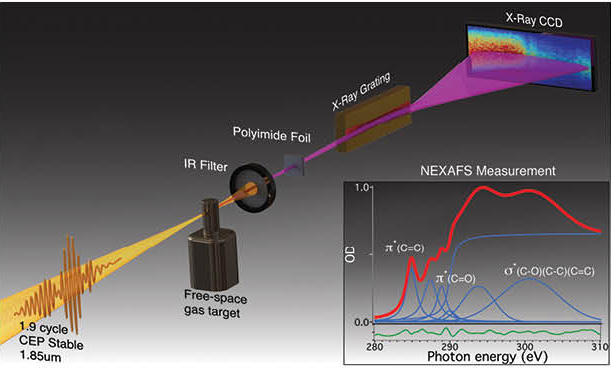 Sub-2-cycle pulses are focused into a high-pressure gas target, generating water window high harmonics. Absorption spectra from a polyimide film [inset] are recorded using an X-ray spectrograph.
Sub-2-cycle pulses are focused into a high-pressure gas target, generating water window high harmonics. Absorption spectra from a polyimide film [inset] are recorded using an X-ray spectrograph.
The “water window”—the wavelength range from 2.3 to 4.5 nm—holds great interest for biologists, chemists and physicists alike. Water is nearly transparent in this range, whereas the K-absorption edges of carbon, nitrogen and oxygen, the building blocks of life, all fall within it. X-rays in this wavelength band are thus incredibly useful for element-specific, high-resolution biological and molecular imaging, spectroscopy, materials science and other applications.
Until now, the only competing sources of these extreme short wavelengths have been facility-scale light sources (synchrotrons and X-ray free electron lasers). Yet high-harmonic generation (HHG) represents a potential unique alternative offering a compact, economic source of short-wavelength radiation on attosecond time scales. Though research since the 1980s has established HHG’s abilities in full spatial and temporal coherence and attosecond pulse generation, recent advances in long-wavelength laser sources have finally enabled the ponderomotive scaling of the HHG photon energy cutoff into the water window.1
We have demonstrated one such high-flux source of water window radiation and applied it to near-edge X-ray fine-structure absorption spectroscopy (NEXAFS) on a polyimide solid-state target.2 The source rests on a highly stable kilohertz laser system that drives an optical parametric amplifier with subsequent hollow-core-fiber pulse compression, and results in sub-2-cycle carrier-envelope-phase-stable laser pulses with a central wavelength of 1.85 µm.
Our phase-matched HHG process, achieved using a high-pressure neon gas target in a free-space geometry, mitigates the low yield expected from HHG generated by a longer-wavelength laser source. High harmonics generated by this source have reached photon energies beyond 400 eV, well beyond the carbon K-edge. This has enabled us to perform high-resolution X-ray absorption spectroscopy on a polyimide foil, in which we identify specific absorption features corresponding to the binding orbitals of the carbon atoms. Absorption spectra are recorded in single five-minute integrations, a fact that suggests the high number of X-ray photons generated.
Ponderomotive scaling of HHG could enable a new era in solid-state physics, with table-top measurements of potentially unprecedented time resolution. The fine-structure measurement at the carbon K edge that we have presented validates, we believe, that probing core level dynamics of matter—such as magnetic changes, superconductivity or phase transitions—will be possible in the solid state and on attosecond timescales.
Researchers
S.L. Cousin, F. Silva, S. Teichmann, M. Hemmer and J. Biegert, ICFO–The Institute of Photonic Sciences, Barcelona, Spain
References
1. H. Xiong et al. Opt. Lett. 34, 1747 (2009).
2. S.L. Cousin et al. Opt. Lett. 39, 5383 (2014).
